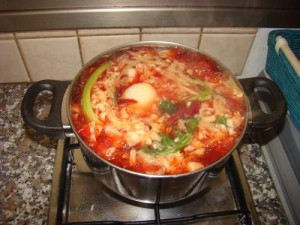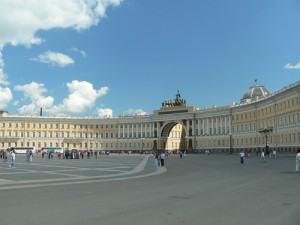This article is written by Geetika Jain
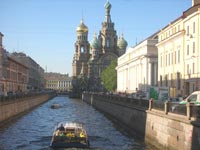 We’re in a boat gliding on St Petersburg’s endearing rivers and canals, taking in the classical and baroque facades of the buildings, and lowering ourselves every now and then to pass under a landmark bridge. The extraordinary thing is that it is 10.30 pm, and the sky is bright blue. A bewitching golden glow lights up the peach and ochre buildings. Couples stand on the sides of bridges, holding on to drinks. They wave when they see us. Groups of teenagers pass by on boats, screaming and waving with both arms at strangers. It is July 21 and at 60 degrees north, the day is being celebrated for its longevity.
We’re in a boat gliding on St Petersburg’s endearing rivers and canals, taking in the classical and baroque facades of the buildings, and lowering ourselves every now and then to pass under a landmark bridge. The extraordinary thing is that it is 10.30 pm, and the sky is bright blue. A bewitching golden glow lights up the peach and ochre buildings. Couples stand on the sides of bridges, holding on to drinks. They wave when they see us. Groups of teenagers pass by on boats, screaming and waving with both arms at strangers. It is July 21 and at 60 degrees north, the day is being celebrated for its longevity.
In late June and early July, people come to St Petersburg to celebrate the ‘White Nights’, when the sun barely sets. This beautiful imperial Russian city was built by Peter the Great three centuries ago and there isn’t a more picturesque backdrop to enjoy the lingering light.
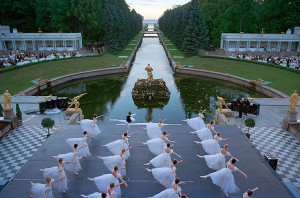 Celebrating White Nights in St Petersburg
Celebrating White Nights in St Petersburg
A lot is packed into these few weeks: Newlywed couples are everywhere, surrounded by friends carrying flowers and bunches of balloons. Brides and grooms like to include the city in their festivities, stopping to take photos against their favourite landmarks – Palace Square and the Hermitage, St Isaac’s Cathedral, The Church on Spilled Blood, Peter the Great’s statue… Following a local tradition, they leave a lock with their names on the ironmongery of a bridge or lamppost, symbolising their own status of being locked in matrimony.
Natalia, our guide, tells us, “Here in Piter, we all do the same thing. All our wedding pictures look exactly the same.”
Light on light
Natalia’s connection with her city is a strong one. Her grandmother survived Hitler’s 900-day siege of the city (the city was known as Leningrad then). Two-thirds of three million people did not make it. The siege started 70 years ago to the day. She spoke of hard times when every available piece of soil was used to grow cabbage and potatoes. Her grandmother had to drink stew made of carpenter’s glue and leather belts to survive, as the daily ration was only a tiny piece of bread. Intense pride stems from this spirited resistance, which, along with other factors, defeated the Nazis.
Natalia loves living in Piter despite the six months of dank darkness. When she is away from home she misses driving around the beautiful buildings on the River Neva’s embankment and having her favourite food – borscht, a beetroot-based soup, beef stroganoff, blinis (pancakes) with caviar and veriniki and ravioli stuffed with savoury and sweet ingredients.
The evening is only just starting. At midnight, we arrive at the enormous Palace Square, and the defiant skies are pale blue with wispy white clouds. The green and gold façade of the Hermitage is beautifully lit. I point to daredevil motorcyclists speeding whilst standing up, but my 19-year-old son is capturing the winsome pouts of bridesmaids who pose for his camera. The newlyweds then release an enormous bunch of helium balloons into the air.
Rise like a bridge
Tomorrow we’ll return to the Hermitage to admire the world’s largest collection of art, started by Catherine the Great, but for now everyone is heading to the embankment around the corner.
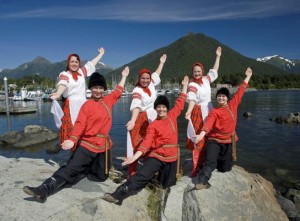
The atmosphere is heady, hundreds of people stand along the coping of the Neva River, milling around the musicians, flame-throwers and food stalls. There are babushkas wearing scarves and clunky shoes, their Slavic eyes smiling. Tripods are steadied and cameras focused. The buildings on both sides of the river are lit like wedding homes and the clouds wield their artistry in the sapphire sky. Starting at 1.30 am, the bridges along the river will lift open one by one, to allow passage to the large cargo ships into the Baltic Sea beyond. People crowd the decks of large boats that will sail under the bridges as they open. Flotillas of smaller motorboats, many packed with screaming teens, join them. The air is rife with anticipation. It is 1.30 now, we are standing next to the Palace Bridge, and the cross-bridge traffic has ceased. Lights below the bridge blink like fireflies, and two central panels of road lift up vertically. There is a loud cry as everyone watches the spectacle. Two distant bridges to the right and left have opened as well, and the silent, businesslike freight ships make their crossing. We wonder if their crew has woken up in the middle of the night to enjoy the phenomenon. We walk up to the bridge; the tarred road looks bizarre standing upright.
Although we walk back to the Astoria Hotel, the streets of Piter will remain animated as the sun will rise before long.
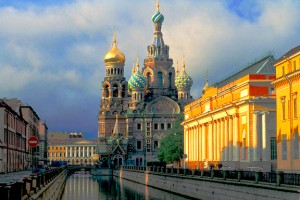 The next day we walk along the canals of Piter, taking in the low-rise, imposing city that was conceived as a ‘Window to Europe’. Its enchanting ensemble of European style edifices often collide with the Byzantine churches and their onion-shaped domes which came later. I quite like the blend as it introduces a welcome Russian flavour.
The next day we walk along the canals of Piter, taking in the low-rise, imposing city that was conceived as a ‘Window to Europe’. Its enchanting ensemble of European style edifices often collide with the Byzantine churches and their onion-shaped domes which came later. I quite like the blend as it introduces a welcome Russian flavour.
Sleep? it’s a waste of time
Natalia weaves in anecdotes from the lives of Tchaikovsky who composed Swan Lake and Sleeping Beauty here and Dostoyevsky, who set Crime and Punishment in these very streets. The yellow painted palace along the Moika canal is where Rasputin the mystic, who cured Tsar Nicholas’s haemophiliac son, was finally assassinated after being poisoned, shot, stabbed and drowned in icy water. Around here, they like to see a job completed.
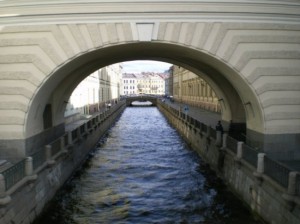 The Moika Canal, St Petersburg
The Moika Canal, St Petersburg
It was here that Vladimir Lenin and Leon Trotsky introduced Marxism to Russia from Germany and started the Bolshevik Revolution in 1917, leading to seven decades of misery.
Putin too is from Piter, and he allocated enormous funds for its 300th year facelift in 2003.
The beautified city will party on for days on end. When the birds head south, the mood will be very different. Reading a book out in the open at midnight will be replaced with driving under streetlights at midday. For now, Piter is ethereally beautiful; the prolonged gloaming has a magical quality. Sleeping is an utter waste of time.
Geetika Jain
8 Aug 2011
http://travel.hindustantimes.com/travel-stories/white-nights-in-st-petersburg.php
